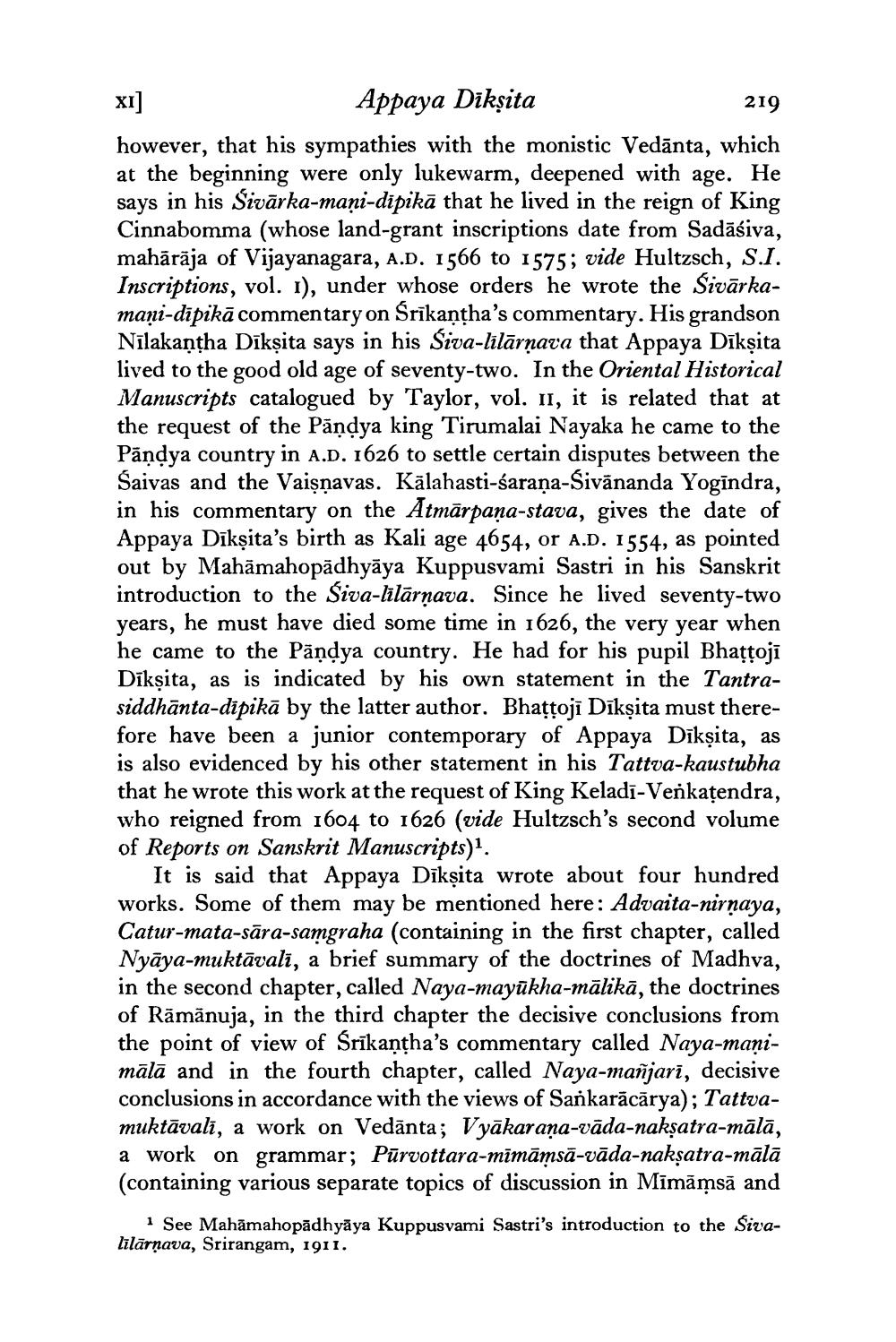________________
XI]
Appaya Dikṣita
219 however, that his sympathies with the monistic Vedānta, which at the beginning were only lukewarm, deepened with age. He says in his Sivārka-maņi-dipikā that he lived in the reign of King Cinnabomma (whose land-grant inscriptions date from Sadāśiva, mahārāja of Vijayanagara, A.D. 1566 to 1575; vide Hultzsch, S.I. Inscriptions, vol. 1), under whose orders he wrote the Sivārkamaņi-dīpikā commentary on Srikantha's commentary. His grandson Nīlakantha Dīkşita says in his Siva-lilārņava that Appaya Dīkṣita lived to the good old age of seventy-two. In the Oriental Historical Manuscripts catalogued by Taylor, vol. ii, it is related that at the request of the Pāņdya king Tirumalai Nayaka he came to the Pāņdya country in A.D. 1626 to settle certain disputes between the Saivas and the Vaisnavas. Kālahasti-sarana-Sivānanda Yogīndra, in his commentary on the Atmārpaņa-stava, gives the date of Appaya Dīkṣita's birth as Kali age 4654, or A.D. 1554, as pointed out by Mahāmahopādhyāya Kuppusvami Sastri in his Sanskrit introduction to the Siva-lilārņava. Since he lived seventy-two years, he must have died some time in 1626, the very year when he came to the Pandya country. He had for his pupil Bhattoji Dīkṣita, as is indicated by his own statement in the Tantrasiddhānta-dipikā by the latter author. Bhattoji Dikșita must therefore have been a junior contemporary of Appaya Dikșita, as is also evidenced by his other statement in his Tattva-kaustubha that he wrote this work at the request of King Keladi-Venkatendra, who reigned from 1604 to 1626 (vide Hultzsch's second volume of Reports on Sanskrit Manuscripts)".
It is said that Appaya Dikșita wrote about four hundred works. Some of them may be mentioned here: Advaita-nirnaya, Catur-mata-sāra-samgraha (containing in the first chapter, called Nyāya-muktāvali, a brief summary of the doctrines of Madhva, in the second chapter, called Naya-mayūkha-mālikā, the doctrines of Rāmānuja, in the third chapter the decisive conclusions from the point of view of Srīkantha's commentary called Naya-maņimālā and in the fourth chapter, called Naya-mañjari, decisive conclusions in accordance with the views of Sankarācārya); Tattvamuktāvalī, a work on Vedānta; Vyākarana-vāda-nakșatra-mālā, a work on grammar; Pūrvottara-mīmāmsā-vāda-nakșatra-mālā (containing various separate topics of discussion in Mīmāņsā and
i See Mahāmahopādhyāya Kuppusvami Sastri's introduction to the Sivalīlārnava, Srirangam, 1911.




